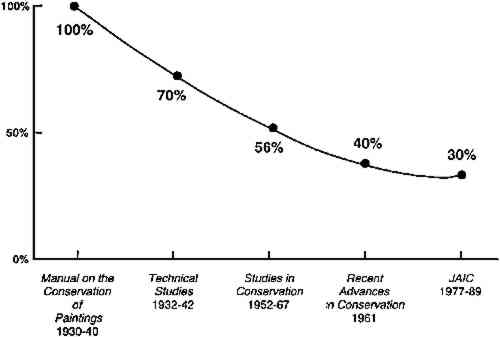THE IMPACT OF RESEARCH ON THE LINING AND CLEANING OF EASEL PAINTINGSJOYCE HILL STONER
3 PAINTING, “THE QUEEN OF THE ARTS”Why was so much of the early history of conservation entirely focused on the treatment of paintings? From Leon Baptista Alberti in the 15th century through Sir Joshua Reynolds in the 18th century, painting was considered “the queen of the arts.” Reynolds discussed a hierarchy of genres within painting that persisted at least through the first half of the 19th century. History painting or grand manner portraits in oil were the highest pursuits for an artist, whereas still life subjects or modest media such as watercolors were considered more suitable for women and other amateurs. In the tradition of Reynolds, paintings conservators were most prominently featured in historic controversies, established most of the early conservation laboratories, and generally ran the conservation organizations. The 1930 conference in Rome and its subsequent published manual (International Museums Office 1940) were concerned only with the treatment of paintings (fig. 1). The 10 volumes of Technical Studies in the Fields of Fine Arts published from 1932 to 1942 contained 79 articles, of which 55 (or 70%) were about examination, care, and treatment of paintings. The International Institute for Conservation was established in 1950 to “coordinate and improve the knowledge, methods, and working standards needed to protect and preserve precious materials of all kinds,” and in 1952 it began publishing Studies in Conservation to carry original scientific and practical papers (Gettens 1969, 12). Its first cumulative index, in 1967, listed 90 articles concerned with paint and paintings, or 56% of the total. Forty percent of the articles in the publication of the IIC Rome conference in 1961 concerned paintings (Thomson 1963). Two subgroups of the International Council of Museums combined in 1967 to form the new ICOM International Committee for Conservation, which publishes a triennial series of papers from its 26 working groups. Specialists in the conservation of furniture or textiles have essentially one key working group session to attend, whereas specialists in the conservation of paintings can attend nine different working group sessions, including “Structural Treatment of Canvas Paintings,” “Easel Paintings on Rigid Supports,” “Murals,” “Icons,” “Resins and Coatings,” and “Contemporary Art.”
The first cumulative index of the Journal of the American Institute for Conservation, 1977–1989 lists only 37 articles on paintings conservation of a total of 122 articles, or 30% of its contents. Considering that there are eight specialty groups in the AIC, this is still perhaps an unfair share. However, members of the other specialty groups may be pleased to note that as new art history methods are revising many of the hierarchies of the canons of art history—including the amateur status of women artists—the supremacy of paintings conservation is also under measurable revision. |
